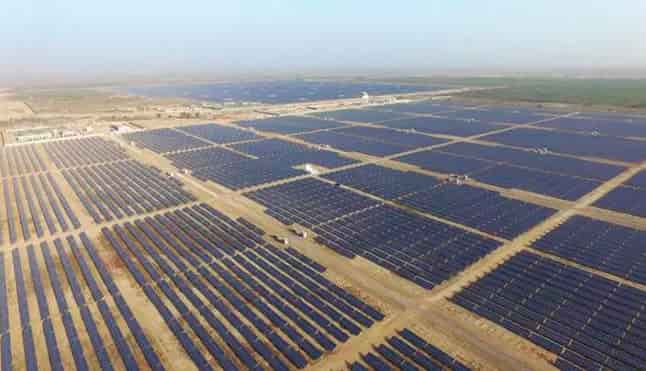
Only in 2018, China installed the power equivalent to 10 nuclear power plants in solar energy. And is that according to the data of the International Energy Agency, 60% of solar panels are built in China. In the short term, discarding coal is not feasible, but the agency estimates that by 2040, half of the Chinese giant's energy production will come from renewable sources.
The largest photovoltaic silver is located in Zhongwei, Ningxia. It is by far the largest solar plant in the world. Both in extension, with an area that covers in its entirety 1,200 square kilometers, as in power, with a maximum production of 1,547 MegaWatts.
3,2% of the total área of the Tengger desert
The largest photovoltaic silver is located in Zhongwei, Ningxia. It is by far the largest solar plant in the world. Both in extension, with an area that covers in its entirety 1,200 square kilometers, as in power, with a maximum production of 1,547 MegaWatts.
The Tengger Desert is an arid region covering an area of 36,700 square kilometers and is located in the autonomous region of Inner Mongolia. The solar plant covers an extension of 3.2% of this land and only taking into account the size of the solar panels themselves have an effective area of 43 square kilometers.
If we look at the list of largest solar plants in the world, we see that the Tengger Desert Solar Park has a power over 500MW greater than the rest of Chinese plants and almost 200MW more than its main rival in India.
Another giant solar plant such as Longyangxia Dam in Tibet has 4 million solar panels. However, its power is "only" 850MW. We do not know the total number of plates of the "Great Wall of the Sun," but it will easily exceed that figure.
In 2017, China's total solar capacity exceeded that of any other country with 130 gigawatts. An amount that if produced at one stroke would serve to feed all of Spain multiple times.
The location of the Tengger Desert Solar Park however is not the best. This is due to China's own geographical disposition. In 1935, the geographer Hu Huanyong drew a line that divided the country into two parts. The situation is that 94% of the country lives in the east zone but according to comments to the BBC, Yuan Xu of the University of Hong Kong, "the distribution of the wind and the resources of the solar energy are completely opposite". And this has its consequence, since the ideal is that the power generation is close to the big cities that are going to consume it.
In a related way, although the production capacity of the solar plant is huge, it does not work at full capacity all the time. According to the data of the 'China Electricity Council', during the first six months of 2018 the capacity of the Chinese solar system worked at 14.7% of its capacity.
The solar plant is managed by the 'State Power Investment Corporation', one of the five major energy companies in China. According to the data of the ESCN, the Ningxia plant included at the end of 2017 up to 98 photovoltaic projects and received state subsidies for a total value of 2.244 billion yuan, almost 300 million euros to the change.
Unrivaled for years, China now sees its position threatened by India
With 1,547 MW reached, the Tengger Desert Solar Park is considered the largest solar plant in the world. However, India has already started a project that aims to rival this production and is even planning to overcome the barrier of 2,000MW.
It is the 'Shakti Sthala' and is located in Pavagada, south of India. It currently operates at almost 1,400MW, but a capacity of 2,225MW is expected when it is completed. It happens that Indian plant is located along five villages, and are lands that belong to the 2,300 farmers of Pavagada. The government decided to lease the entire land and pay rent to its owners, so the total cost of the project rose to 2,530 million dollars.
China is the main solar market in the world, but India aims to overtake the United States and place itself in second place. Solar energy is already the cheapest energy in almost 60 countries. And although in countries like Spain we are still in the early stages, China continues to generate millions of watts of energy through its giant solar plants in the middle of the desert.
Xataka.com
